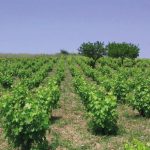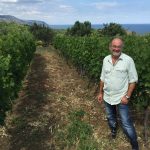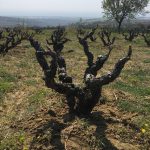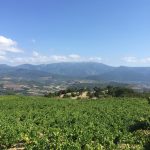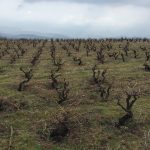Wines of unique Terroirs
All our wines are made with fruits of single vineyards.
Kaynaklar, İzmir
Our Serez vineyard has a stony, gravely and clay red soil at an altitude of 235 meters. This altitude gives the possibility of day and night temperature differences during late August and early September, namely during the harvest period. It ensures that the grapes retain their acidity while reaching sugar and phenolic maturity. As a result, concentrated, full bodied and fruity, but at the same time balanced and elegant wines can be produced.
We planted our vineyard in 2002, a single vineyard of 4 hectares near Kaynaklar village of Buca District of İzmir with varietals of Cabernet Sauvignon, Cabernet Franc, Merlot and Petit Verdot, appropriate for a typical Bordeaux blend… We imported our vines from Pepinieres Guillaume; grafted with clones yielding quality grapes on to American rootstocks suitable to our “terroir”. Planting of the vines was done dense, channeling the energies of the plants to root development rather than yielding many kilos of fruit. We reduce number of shoots in May. In short, we deliberately obtain low yields. Also we “green harvest” in July certain clusters so that remaining clusters have better quality and taste.
We make two Bordeaux blend wines with the fruit of Serez vineyard.
Kaynaklar lies 20 km south of the port city of Izmir. A 100 years ago this area was full of vineyards. Turkey ended up on the loosing side at WWI and western part of Turkey was occupied by Greece. This lead to Turkish War of Independence against the occupiers and much destruction was caused by the invading army. We are glad to be restoring vineyards to Kaynaklar.
Hoşköy, Tekirdağ
Our vineyards in Hoşköy have partly clay and limy soil with high mineral content. They are at altitudes of 140 to 160 meters, and open to the winds blowing from Sea of Marmara. Thus, our grapes stay “cool” during late August and early September and retain their acidity. Therefore we are able to produce concentrated, full bodied and fruit driven big wines, but also balanced and elegant.
We began to plant our Hoşköy vineyards in 2003, and still continue… Our vineyards neighbour to each other totaling 6 hectares. Back in 2003 we planted varietals of Cabernet Sauvignon, Cabernet Franc, Merlot and Petit Verdot. We imported our vines from Pepinieres Guillaume; grafted with clones yielding quality grapes on to American rootstocks suitable to our “terroir”.
Later on, starting in 2005, we began to plant Kolorko, an indigenous variety of Thrace in Turkey-in-Europe that had almost become extinct. It is an interesting variety that can turn into unique white wines with good acidity and minerality. Our wish was and still is to save this indigenous variety from extinction and ensure that it is passed to the future generations. Every year we plant a little more, growing our production. We are glad to see Kolorko variety’s progress from a possible extinction to an export wine of ours…
Şarköy, Tekirdağ
Our “dream” vineyard in Şarköy has deep, well drained loamy soil with medium lime content (with an ideal pH for vine growing). It is 3 km inland from the Sea of Marmara facing directly the Sea and its winds. It is at 200 meters above sea level with a gentle slope that allows good drainage.
This vineyard has 50 plus year “old vines” that were planted in late 1960’s with Yapıncak variety which is an indigenous variety to Thrace in Turkey-in-Europe. This is the reason we refer to it as our “dream” vineyard. The vines are free standing bush vines.
We first came across this vineyard back in 2011. Due to its old vines we thought it would be ideal for quality wines. We were the first winery in Turkey to bottle a 100% Yapıncak. Some people thought we were crazy bottling this variety:) Our 2011 vintage Yapıncak was awarded a Gold Medal and Best of Nation award at San Francisco International Wine Competition. It was the first Gold Medal and first Best of Nation award given to a Turkish winery at SFIWC.
This vineyard was in the hands of a family for 3 generations who live in the town of Şarköy. The ownership had split into more and more relatives with each generation. When we started to buy their fruit in 2011 there were 22 partners who were all related; uncles, aunties, brothers, sisters, nephews, nieces… One amongst them (Hasan enişte) was tending the vines while the others were just collecting their share of the income.
We always wanted to own this vineyard but we also knew that it would be a challenging job to convince all 22 partners. Eventually in early 2017 such an oppurtunity came and we are now the sole owners. Dreams do come true:)
Currently the wines produced with the fruit of these “old vines” are 100% exported.
And we started with 2017 vintage to make a “skin contact” wine (aka orange wine and / or amber wine) with Yapıncak.
Starting in 2018 we began to plant more Yapıncak in the adjacent lands to the south and to the north of the old vines to expand our production. These young vines will be going into a 2nd wine.
Gedik, Çanakkale
Kaz Dağları is a national park that lies in the northern part of the Aegean region of Turkey. It is home to some 800 plants, many of them unique to Turkey. It is also home to jackals, mountain deers, wolves, bears, rabbits, lynixes, squirrels, wild boars and many birds, and home to evergreen forests, small lakes, waterfalls, creeks, and home to 1000 springs.
In English it is known as Mount Ida, a sacred mountain. According to Greek mythology it is where Zeus resides. This is also the mountain of Mother Goddess Cybele. Mount Ida is also mentioned in Homer’s epic poem the Iliad.
Kaz Dağları is also the home of Sarıkız (Fair Maiden) myth, a girl with special powers helping wanderers who, according to the legend, had lost their ways on the mountain. Her memory is still celebrated and honored by the locals of the neighbouring villages who gather annually on the mountain peak.
Just to the north of Kaz Dağları lies an ancient viticultural area where Karasakız, Sıdalan and Çakal varieties are grown. All three are indigenous to this area…
This viticultural area is some 20 km away from the ancient city of Troy.
Our never ending quest for the indigienous varieties of Turkey brought us here back in 2009. In those days Karasakız, a thin skinned black variety, was almost unknown even in Turkey. We thought from day one that such a thin skinned variety would make very elegant red wines… Together with Andrea Paoletti we spent many days visiting various villages, checking out many vineyards, analysing and understanding soil types, paying attention to altitudes and slope positionings against the sun. We eventually decided the village of Gedik was probably the best location for what we were looking for.
The vineyards surrounding the village generally run from 300 meters to 600 meters above sea level. And almost all of them face towards to south varying from south-east to south to south-west.
For 10 years we purchased Karasakız fruit from various vineyards around the village. Our experiences have allowed us to better understand the different qualities of Karasakız each vineyard, each “terroir” gives. In February of 2019 our favourite vineyard was up for sale. We jumped on the opportunity and were able to purchase this “jewel”.
This vineyard has 35 plus year “old vines” that were planted in mid 1980’s with low yielding Karasakız. The vines are free standing bush vines at an altitude of 500 meters above sea level facing south towards Kaz Dağları national park. It has dark brown loamy soils on a gentle slope. The fruit is used 100% for our Old Vines 6N Karasakız wine and also used as part of the blend for our usual 6N Karasakız wine.
Starting in the Spring of 2020 we began to plant more Karasakız in the adjacent lands to the north of the old vines to expand our production. These young vines will be going into our 6N Karasakız wine.
Sıdalan and Çakal varieties are also grown around the village of Gedik.
Sıdalan is grown in relativelly small quantities. We have been commercially making a 100% Sıdalan white since 2016. Starting with 2019 vintage we are also making a “skin contact” wine (aka orange / amber wine) with Sıdalan…
Çakal variety is almost extinct. It has been a victim of its skin colour which is a pinkish red. This colour is not dark enough for a red wine but gives of too much colour for a white wine. Therefore it was an “unwanted” grape and over the decades it was cut down and replaced by other varieties. There are now less than 2 dozen growers left, each growing minute quantities.
Çakal variety is named after the animal jackal. It ripens earlier then other varieties in the region and therefore gets sweeter before the others. The jackals from the hills come down and eat the sweet grapes; hence the name jackal. We are making a pale rose and also a “skin contact” rose of Çakal variety…
Starting in the Spring of 2020 we also began the process to plant Sıdalan and Çakal varieties in our vineyard. Our wish is to expand production on both varieties but also save them for the future generations.











